Object and Data Modelling: Design of Car Parking Information System
VerifiedAdded on 2023/06/13
|12
|2879
|419
Report
AI Summary
This report provides a detailed architecture and design of a car parking system using object and data modeling techniques. It identifies and describes the main functional requirements such as generating tickets, accepting tickets, handling payments, recording problems, security management, storing customer details, calculating parking fees, and parking access. The non-functional requirements cover user interface design, data integrity, adaptability, and accessibility. A use case model is presented with descriptions for each use case, including a fully developed use case for making payments. A UML domain model class diagram is included to represent all systems. The report also outlines specific tasks required for each design activity in the Software Development Life Cycle (SDLC), including planning, analysis, design, implementation, testing, and maintenance.
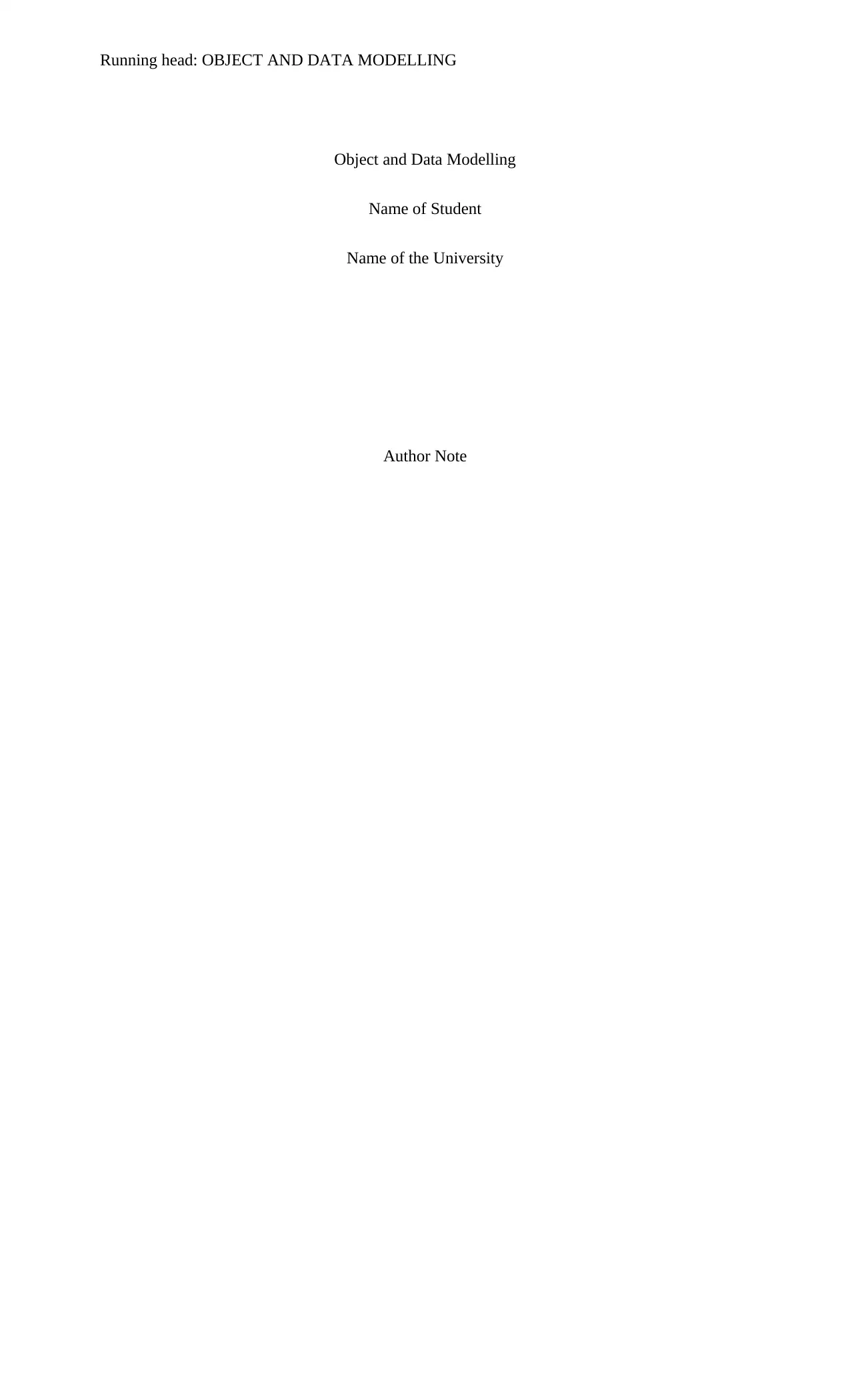
Running head: OBJECT AND DATA MODELLING
Object and Data Modelling
Name of Student
Name of the University
Author Note
Object and Data Modelling
Name of Student
Name of the University
Author Note
Paraphrase This Document
Need a fresh take? Get an instant paraphrase of this document with our AI Paraphraser
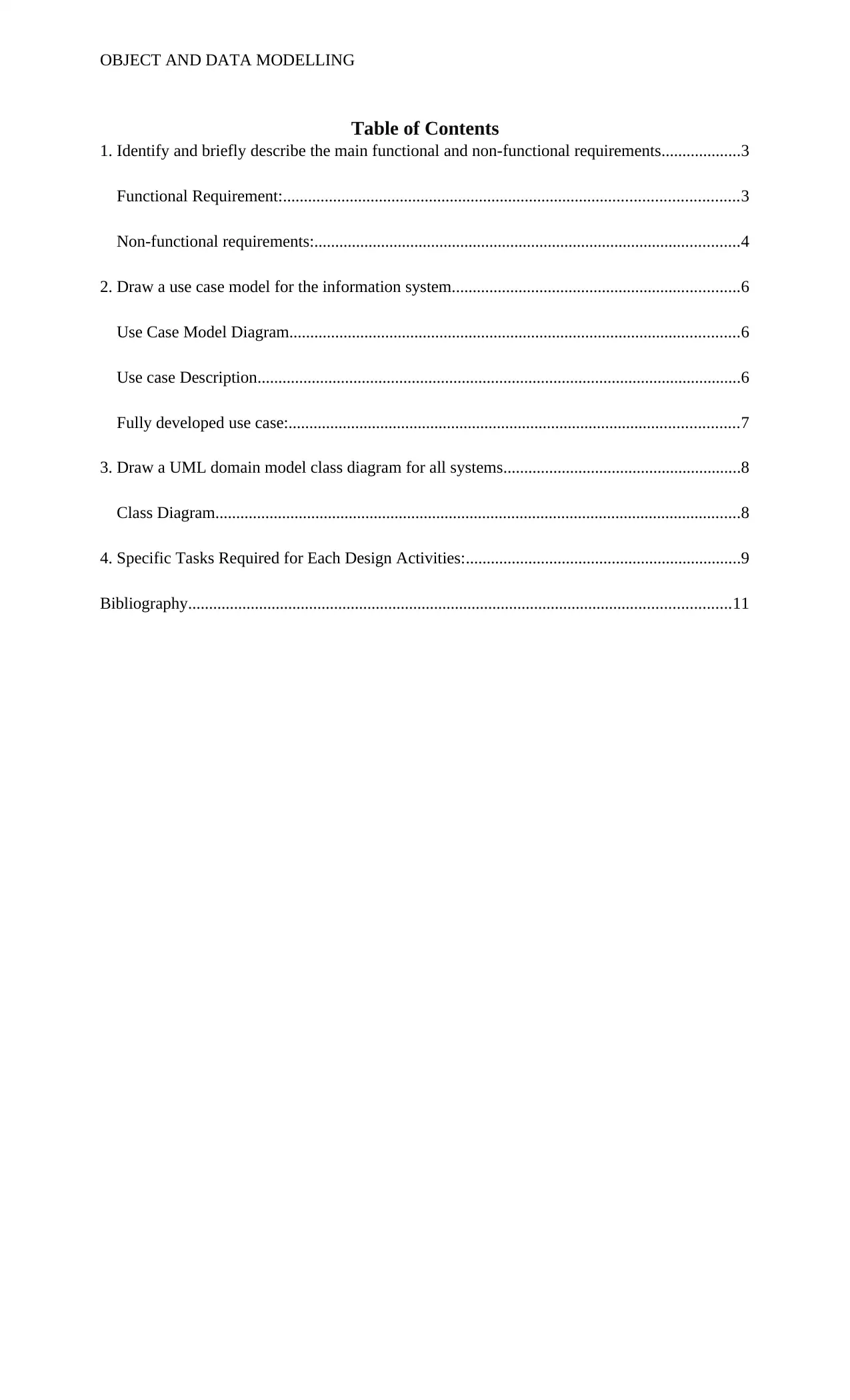
OBJECT AND DATA MODELLING
Table of Contents
1. Identify and briefly describe the main functional and non-functional requirements...................3
Functional Requirement:.............................................................................................................3
Non-functional requirements:......................................................................................................4
2. Draw a use case model for the information system.....................................................................6
Use Case Model Diagram............................................................................................................6
Use case Description....................................................................................................................6
Fully developed use case:............................................................................................................7
3. Draw a UML domain model class diagram for all systems.........................................................8
Class Diagram..............................................................................................................................8
4. Specific Tasks Required for Each Design Activities:..................................................................9
Bibliography..................................................................................................................................11
Table of Contents
1. Identify and briefly describe the main functional and non-functional requirements...................3
Functional Requirement:.............................................................................................................3
Non-functional requirements:......................................................................................................4
2. Draw a use case model for the information system.....................................................................6
Use Case Model Diagram............................................................................................................6
Use case Description....................................................................................................................6
Fully developed use case:............................................................................................................7
3. Draw a UML domain model class diagram for all systems.........................................................8
Class Diagram..............................................................................................................................8
4. Specific Tasks Required for Each Design Activities:..................................................................9
Bibliography..................................................................................................................................11
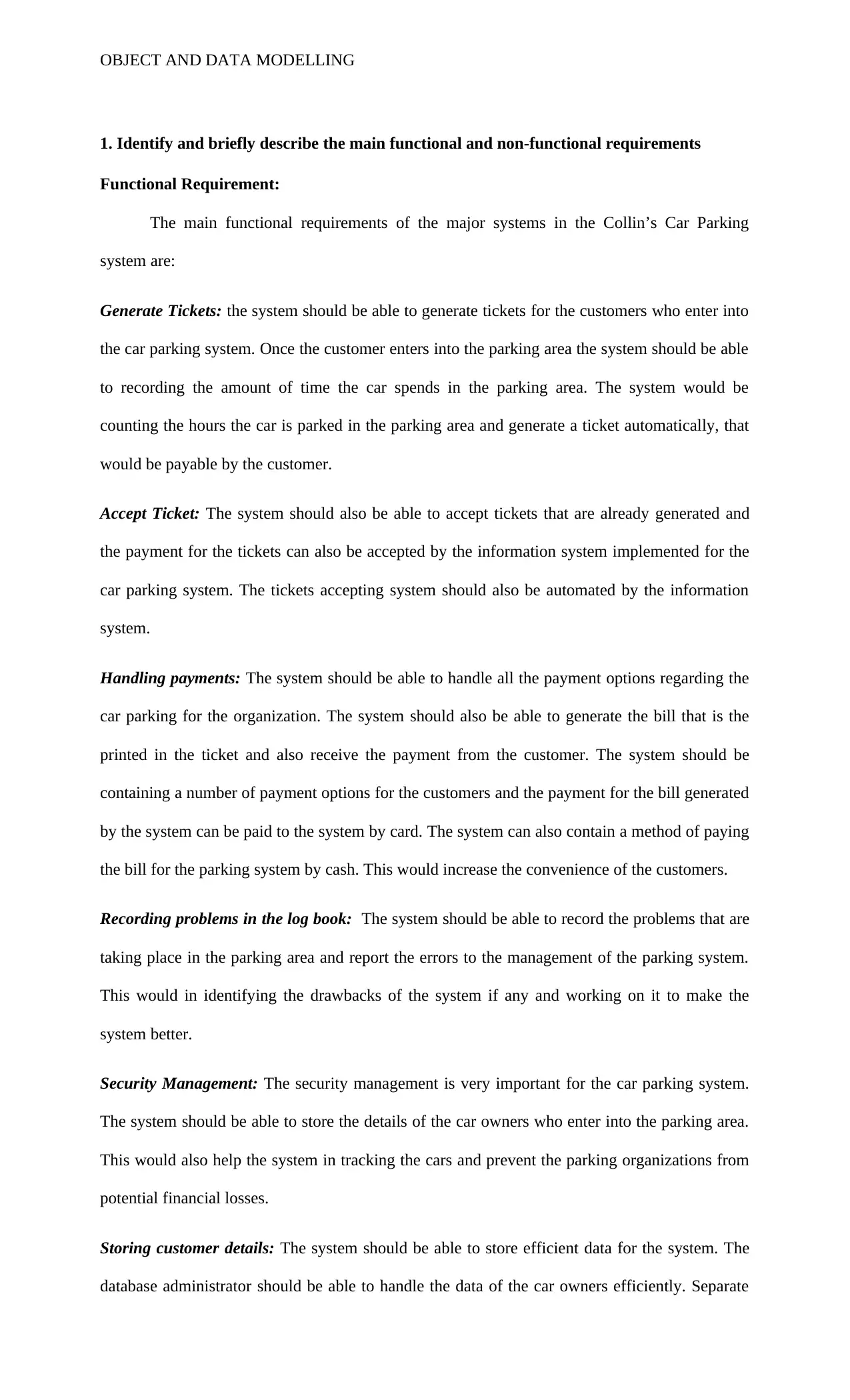
OBJECT AND DATA MODELLING
1. Identify and briefly describe the main functional and non-functional requirements
Functional Requirement:
The main functional requirements of the major systems in the Collin’s Car Parking
system are:
Generate Tickets: the system should be able to generate tickets for the customers who enter into
the car parking system. Once the customer enters into the parking area the system should be able
to recording the amount of time the car spends in the parking area. The system would be
counting the hours the car is parked in the parking area and generate a ticket automatically, that
would be payable by the customer.
Accept Ticket: The system should also be able to accept tickets that are already generated and
the payment for the tickets can also be accepted by the information system implemented for the
car parking system. The tickets accepting system should also be automated by the information
system.
Handling payments: The system should be able to handle all the payment options regarding the
car parking for the organization. The system should also be able to generate the bill that is the
printed in the ticket and also receive the payment from the customer. The system should be
containing a number of payment options for the customers and the payment for the bill generated
by the system can be paid to the system by card. The system can also contain a method of paying
the bill for the parking system by cash. This would increase the convenience of the customers.
Recording problems in the log book: The system should be able to record the problems that are
taking place in the parking area and report the errors to the management of the parking system.
This would in identifying the drawbacks of the system if any and working on it to make the
system better.
Security Management: The security management is very important for the car parking system.
The system should be able to store the details of the car owners who enter into the parking area.
This would also help the system in tracking the cars and prevent the parking organizations from
potential financial losses.
Storing customer details: The system should be able to store efficient data for the system. The
database administrator should be able to handle the data of the car owners efficiently. Separate
1. Identify and briefly describe the main functional and non-functional requirements
Functional Requirement:
The main functional requirements of the major systems in the Collin’s Car Parking
system are:
Generate Tickets: the system should be able to generate tickets for the customers who enter into
the car parking system. Once the customer enters into the parking area the system should be able
to recording the amount of time the car spends in the parking area. The system would be
counting the hours the car is parked in the parking area and generate a ticket automatically, that
would be payable by the customer.
Accept Ticket: The system should also be able to accept tickets that are already generated and
the payment for the tickets can also be accepted by the information system implemented for the
car parking system. The tickets accepting system should also be automated by the information
system.
Handling payments: The system should be able to handle all the payment options regarding the
car parking for the organization. The system should also be able to generate the bill that is the
printed in the ticket and also receive the payment from the customer. The system should be
containing a number of payment options for the customers and the payment for the bill generated
by the system can be paid to the system by card. The system can also contain a method of paying
the bill for the parking system by cash. This would increase the convenience of the customers.
Recording problems in the log book: The system should be able to record the problems that are
taking place in the parking area and report the errors to the management of the parking system.
This would in identifying the drawbacks of the system if any and working on it to make the
system better.
Security Management: The security management is very important for the car parking system.
The system should be able to store the details of the car owners who enter into the parking area.
This would also help the system in tracking the cars and prevent the parking organizations from
potential financial losses.
Storing customer details: The system should be able to store efficient data for the system. The
database administrator should be able to handle the data of the car owners efficiently. Separate
⊘ This is a preview!⊘
Do you want full access?
Subscribe today to unlock all pages.

Trusted by 1+ million students worldwide
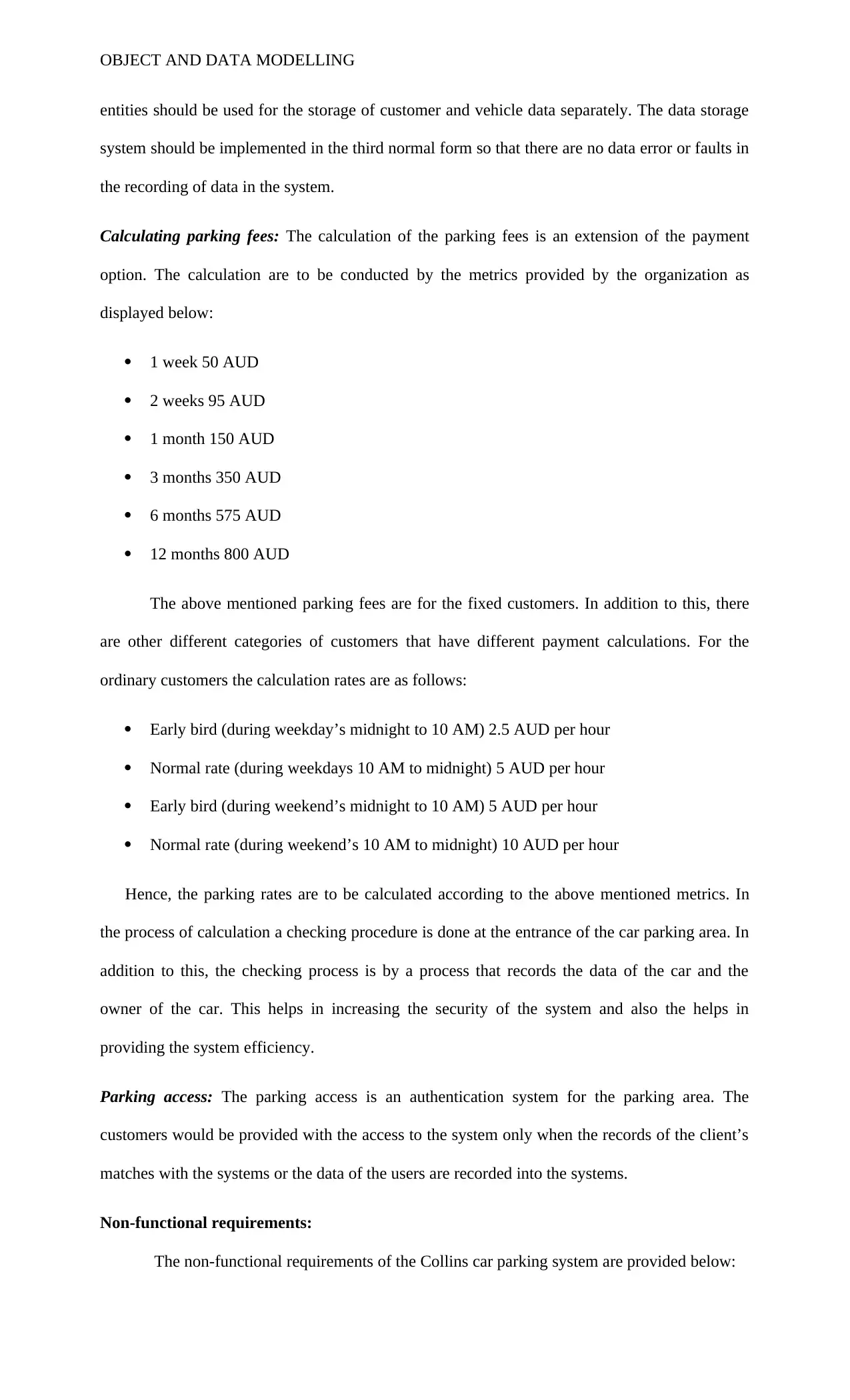
OBJECT AND DATA MODELLING
entities should be used for the storage of customer and vehicle data separately. The data storage
system should be implemented in the third normal form so that there are no data error or faults in
the recording of data in the system.
Calculating parking fees: The calculation of the parking fees is an extension of the payment
option. The calculation are to be conducted by the metrics provided by the organization as
displayed below:
1 week 50 AUD
2 weeks 95 AUD
1 month 150 AUD
3 months 350 AUD
6 months 575 AUD
12 months 800 AUD
The above mentioned parking fees are for the fixed customers. In addition to this, there
are other different categories of customers that have different payment calculations. For the
ordinary customers the calculation rates are as follows:
Early bird (during weekday’s midnight to 10 AM) 2.5 AUD per hour
Normal rate (during weekdays 10 AM to midnight) 5 AUD per hour
Early bird (during weekend’s midnight to 10 AM) 5 AUD per hour
Normal rate (during weekend’s 10 AM to midnight) 10 AUD per hour
Hence, the parking rates are to be calculated according to the above mentioned metrics. In
the process of calculation a checking procedure is done at the entrance of the car parking area. In
addition to this, the checking process is by a process that records the data of the car and the
owner of the car. This helps in increasing the security of the system and also the helps in
providing the system efficiency.
Parking access: The parking access is an authentication system for the parking area. The
customers would be provided with the access to the system only when the records of the client’s
matches with the systems or the data of the users are recorded into the systems.
Non-functional requirements:
The non-functional requirements of the Collins car parking system are provided below:
entities should be used for the storage of customer and vehicle data separately. The data storage
system should be implemented in the third normal form so that there are no data error or faults in
the recording of data in the system.
Calculating parking fees: The calculation of the parking fees is an extension of the payment
option. The calculation are to be conducted by the metrics provided by the organization as
displayed below:
1 week 50 AUD
2 weeks 95 AUD
1 month 150 AUD
3 months 350 AUD
6 months 575 AUD
12 months 800 AUD
The above mentioned parking fees are for the fixed customers. In addition to this, there
are other different categories of customers that have different payment calculations. For the
ordinary customers the calculation rates are as follows:
Early bird (during weekday’s midnight to 10 AM) 2.5 AUD per hour
Normal rate (during weekdays 10 AM to midnight) 5 AUD per hour
Early bird (during weekend’s midnight to 10 AM) 5 AUD per hour
Normal rate (during weekend’s 10 AM to midnight) 10 AUD per hour
Hence, the parking rates are to be calculated according to the above mentioned metrics. In
the process of calculation a checking procedure is done at the entrance of the car parking area. In
addition to this, the checking process is by a process that records the data of the car and the
owner of the car. This helps in increasing the security of the system and also the helps in
providing the system efficiency.
Parking access: The parking access is an authentication system for the parking area. The
customers would be provided with the access to the system only when the records of the client’s
matches with the systems or the data of the users are recorded into the systems.
Non-functional requirements:
The non-functional requirements of the Collins car parking system are provided below:
Paraphrase This Document
Need a fresh take? Get an instant paraphrase of this document with our AI Paraphraser
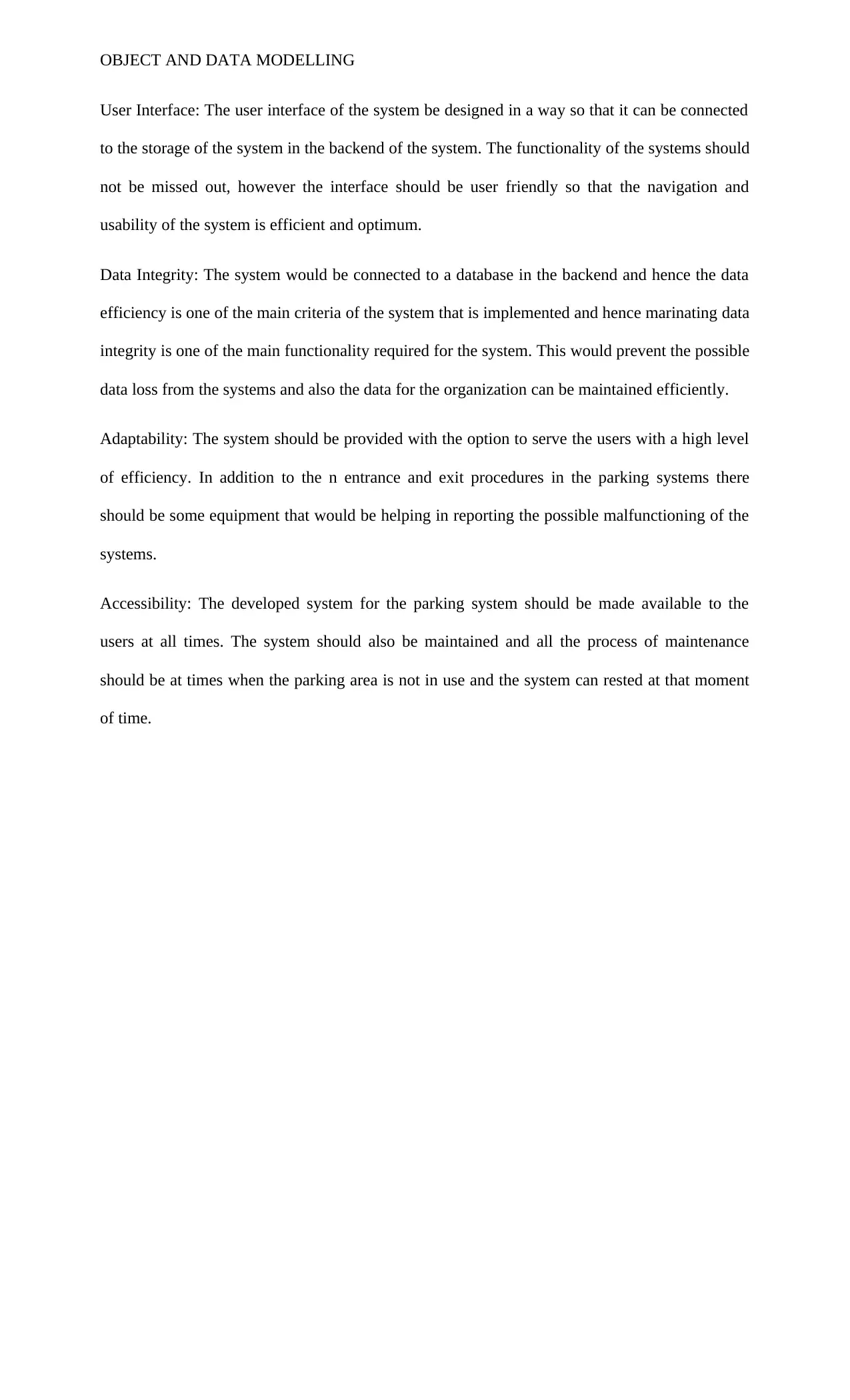
OBJECT AND DATA MODELLING
User Interface: The user interface of the system be designed in a way so that it can be connected
to the storage of the system in the backend of the system. The functionality of the systems should
not be missed out, however the interface should be user friendly so that the navigation and
usability of the system is efficient and optimum.
Data Integrity: The system would be connected to a database in the backend and hence the data
efficiency is one of the main criteria of the system that is implemented and hence marinating data
integrity is one of the main functionality required for the system. This would prevent the possible
data loss from the systems and also the data for the organization can be maintained efficiently.
Adaptability: The system should be provided with the option to serve the users with a high level
of efficiency. In addition to the n entrance and exit procedures in the parking systems there
should be some equipment that would be helping in reporting the possible malfunctioning of the
systems.
Accessibility: The developed system for the parking system should be made available to the
users at all times. The system should also be maintained and all the process of maintenance
should be at times when the parking area is not in use and the system can rested at that moment
of time.
User Interface: The user interface of the system be designed in a way so that it can be connected
to the storage of the system in the backend of the system. The functionality of the systems should
not be missed out, however the interface should be user friendly so that the navigation and
usability of the system is efficient and optimum.
Data Integrity: The system would be connected to a database in the backend and hence the data
efficiency is one of the main criteria of the system that is implemented and hence marinating data
integrity is one of the main functionality required for the system. This would prevent the possible
data loss from the systems and also the data for the organization can be maintained efficiently.
Adaptability: The system should be provided with the option to serve the users with a high level
of efficiency. In addition to the n entrance and exit procedures in the parking systems there
should be some equipment that would be helping in reporting the possible malfunctioning of the
systems.
Accessibility: The developed system for the parking system should be made available to the
users at all times. The system should also be maintained and all the process of maintenance
should be at times when the parking area is not in use and the system can rested at that moment
of time.
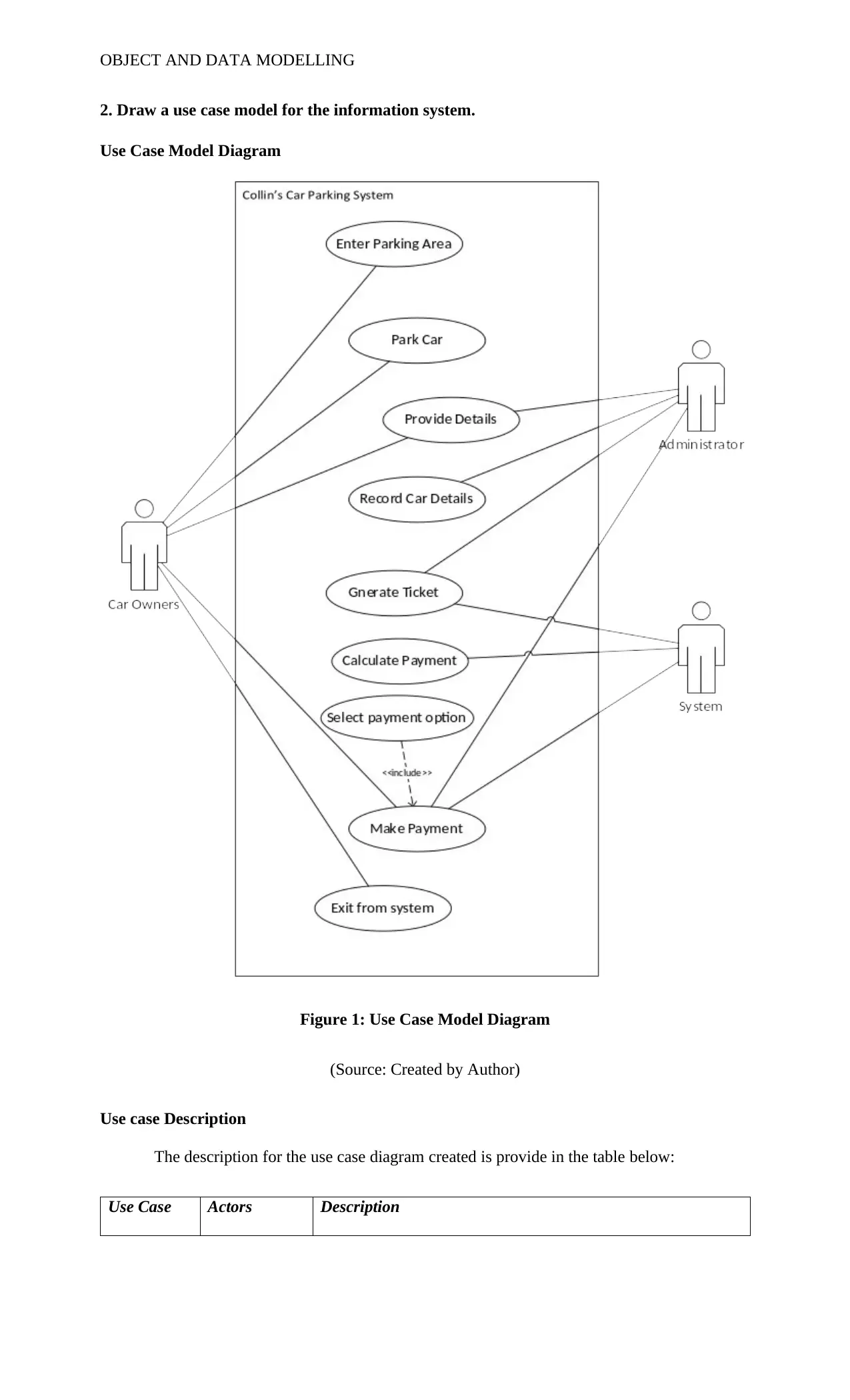
OBJECT AND DATA MODELLING
2. Draw a use case model for the information system.
Use Case Model Diagram
Figure 1: Use Case Model Diagram
(Source: Created by Author)
Use case Description
The description for the use case diagram created is provide in the table below:
Use Case Actors Description
2. Draw a use case model for the information system.
Use Case Model Diagram
Figure 1: Use Case Model Diagram
(Source: Created by Author)
Use case Description
The description for the use case diagram created is provide in the table below:
Use Case Actors Description
⊘ This is a preview!⊘
Do you want full access?
Subscribe today to unlock all pages.

Trusted by 1+ million students worldwide
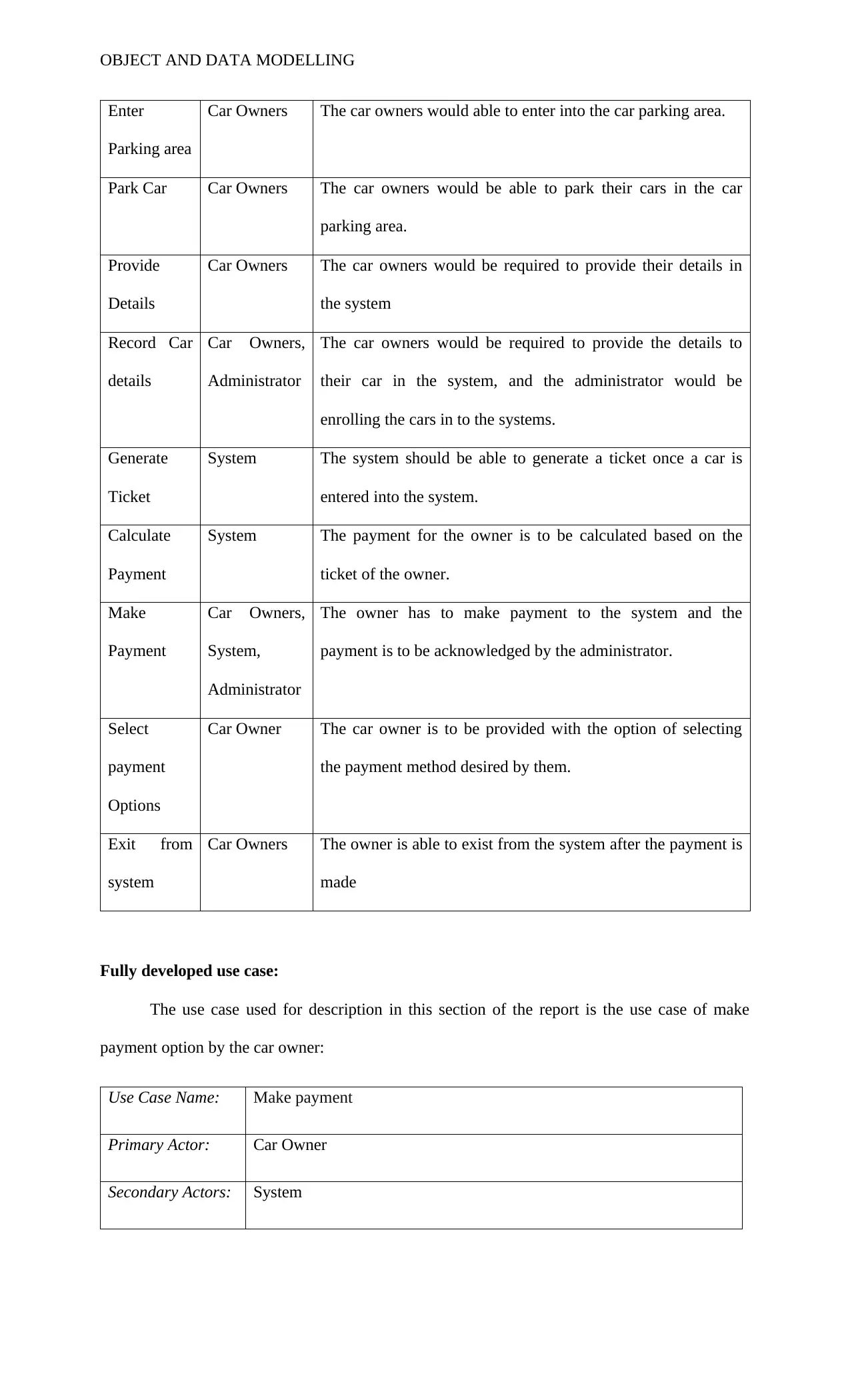
OBJECT AND DATA MODELLING
Enter
Parking area
Car Owners The car owners would able to enter into the car parking area.
Park Car Car Owners The car owners would be able to park their cars in the car
parking area.
Provide
Details
Car Owners The car owners would be required to provide their details in
the system
Record Car
details
Car Owners,
Administrator
The car owners would be required to provide the details to
their car in the system, and the administrator would be
enrolling the cars in to the systems.
Generate
Ticket
System The system should be able to generate a ticket once a car is
entered into the system.
Calculate
Payment
System The payment for the owner is to be calculated based on the
ticket of the owner.
Make
Payment
Car Owners,
System,
Administrator
The owner has to make payment to the system and the
payment is to be acknowledged by the administrator.
Select
payment
Options
Car Owner The car owner is to be provided with the option of selecting
the payment method desired by them.
Exit from
system
Car Owners The owner is able to exist from the system after the payment is
made
Fully developed use case:
The use case used for description in this section of the report is the use case of make
payment option by the car owner:
Use Case Name: Make payment
Primary Actor: Car Owner
Secondary Actors: System
Enter
Parking area
Car Owners The car owners would able to enter into the car parking area.
Park Car Car Owners The car owners would be able to park their cars in the car
parking area.
Provide
Details
Car Owners The car owners would be required to provide their details in
the system
Record Car
details
Car Owners,
Administrator
The car owners would be required to provide the details to
their car in the system, and the administrator would be
enrolling the cars in to the systems.
Generate
Ticket
System The system should be able to generate a ticket once a car is
entered into the system.
Calculate
Payment
System The payment for the owner is to be calculated based on the
ticket of the owner.
Make
Payment
Car Owners,
System,
Administrator
The owner has to make payment to the system and the
payment is to be acknowledged by the administrator.
Select
payment
Options
Car Owner The car owner is to be provided with the option of selecting
the payment method desired by them.
Exit from
system
Car Owners The owner is able to exist from the system after the payment is
made
Fully developed use case:
The use case used for description in this section of the report is the use case of make
payment option by the car owner:
Use Case Name: Make payment
Primary Actor: Car Owner
Secondary Actors: System
Paraphrase This Document
Need a fresh take? Get an instant paraphrase of this document with our AI Paraphraser
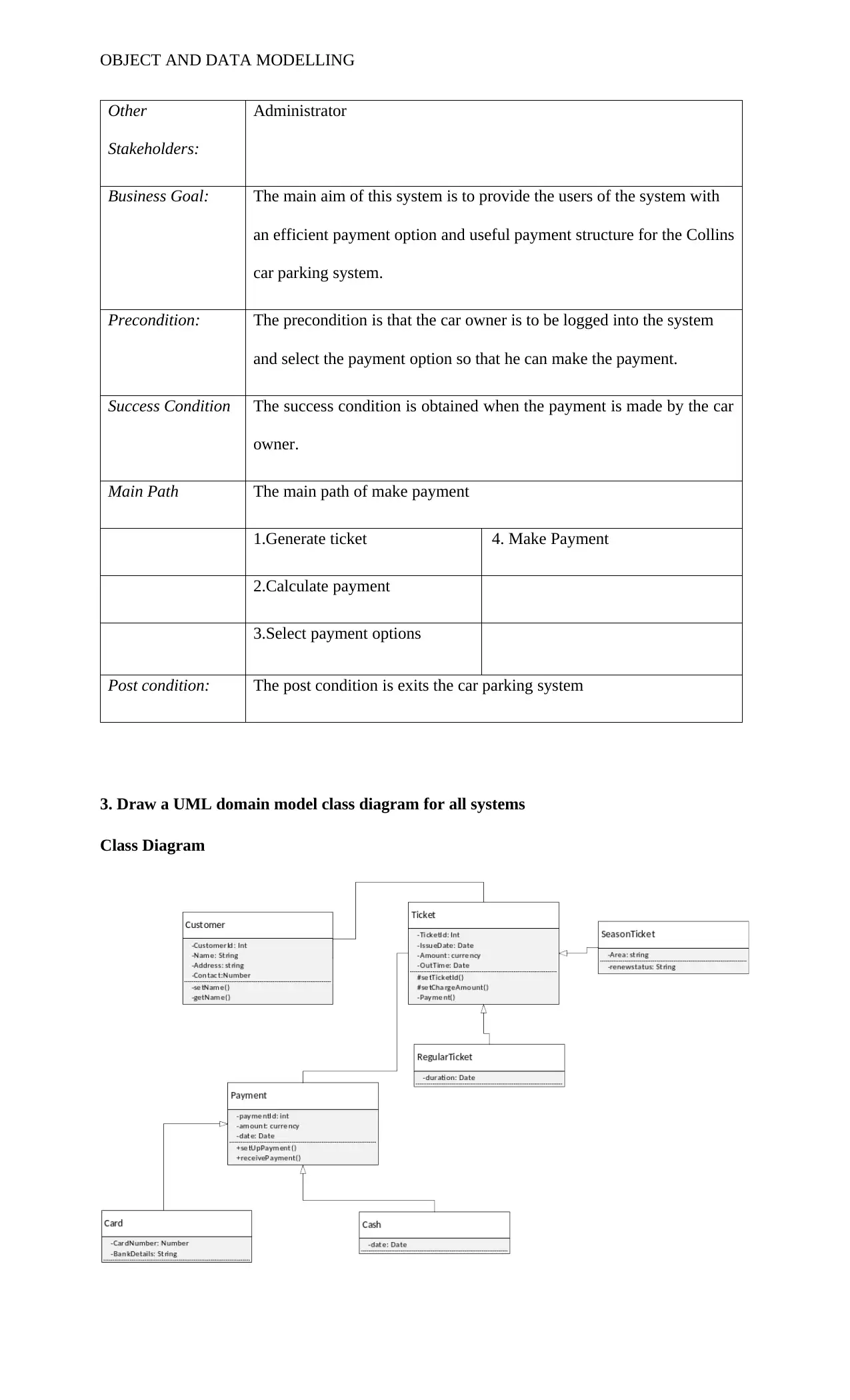
OBJECT AND DATA MODELLING
Other
Stakeholders:
Administrator
Business Goal: The main aim of this system is to provide the users of the system with
an efficient payment option and useful payment structure for the Collins
car parking system.
Precondition: The precondition is that the car owner is to be logged into the system
and select the payment option so that he can make the payment.
Success Condition The success condition is obtained when the payment is made by the car
owner.
Main Path The main path of make payment
1.Generate ticket 4. Make Payment
2.Calculate payment
3.Select payment options
Post condition: The post condition is exits the car parking system
3. Draw a UML domain model class diagram for all systems
Class Diagram
Other
Stakeholders:
Administrator
Business Goal: The main aim of this system is to provide the users of the system with
an efficient payment option and useful payment structure for the Collins
car parking system.
Precondition: The precondition is that the car owner is to be logged into the system
and select the payment option so that he can make the payment.
Success Condition The success condition is obtained when the payment is made by the car
owner.
Main Path The main path of make payment
1.Generate ticket 4. Make Payment
2.Calculate payment
3.Select payment options
Post condition: The post condition is exits the car parking system
3. Draw a UML domain model class diagram for all systems
Class Diagram
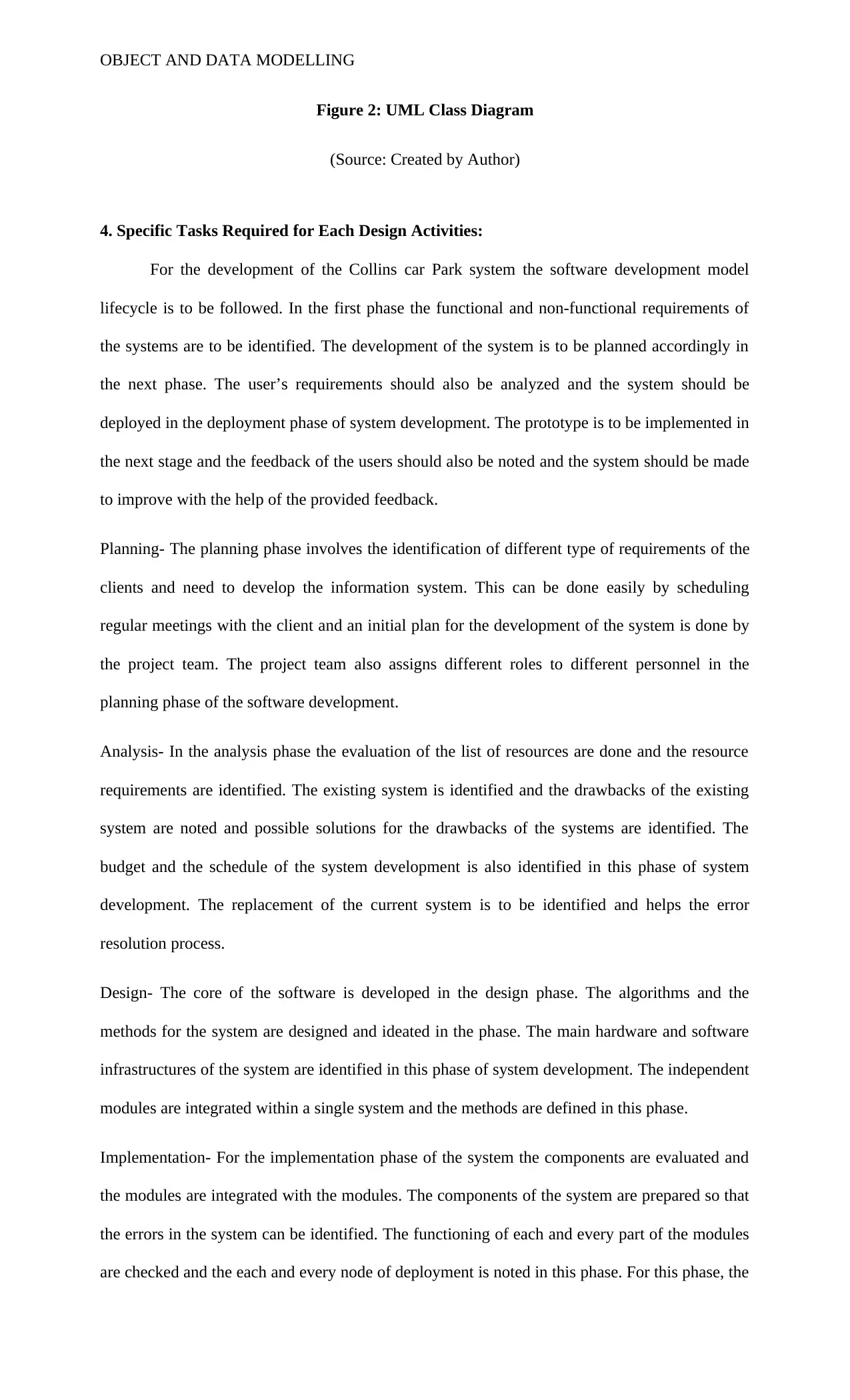
OBJECT AND DATA MODELLING
Figure 2: UML Class Diagram
(Source: Created by Author)
4. Specific Tasks Required for Each Design Activities:
For the development of the Collins car Park system the software development model
lifecycle is to be followed. In the first phase the functional and non-functional requirements of
the systems are to be identified. The development of the system is to be planned accordingly in
the next phase. The user’s requirements should also be analyzed and the system should be
deployed in the deployment phase of system development. The prototype is to be implemented in
the next stage and the feedback of the users should also be noted and the system should be made
to improve with the help of the provided feedback.
Planning- The planning phase involves the identification of different type of requirements of the
clients and need to develop the information system. This can be done easily by scheduling
regular meetings with the client and an initial plan for the development of the system is done by
the project team. The project team also assigns different roles to different personnel in the
planning phase of the software development.
Analysis- In the analysis phase the evaluation of the list of resources are done and the resource
requirements are identified. The existing system is identified and the drawbacks of the existing
system are noted and possible solutions for the drawbacks of the systems are identified. The
budget and the schedule of the system development is also identified in this phase of system
development. The replacement of the current system is to be identified and helps the error
resolution process.
Design- The core of the software is developed in the design phase. The algorithms and the
methods for the system are designed and ideated in the phase. The main hardware and software
infrastructures of the system are identified in this phase of system development. The independent
modules are integrated within a single system and the methods are defined in this phase.
Implementation- For the implementation phase of the system the components are evaluated and
the modules are integrated with the modules. The components of the system are prepared so that
the errors in the system can be identified. The functioning of each and every part of the modules
are checked and the each and every node of deployment is noted in this phase. For this phase, the
Figure 2: UML Class Diagram
(Source: Created by Author)
4. Specific Tasks Required for Each Design Activities:
For the development of the Collins car Park system the software development model
lifecycle is to be followed. In the first phase the functional and non-functional requirements of
the systems are to be identified. The development of the system is to be planned accordingly in
the next phase. The user’s requirements should also be analyzed and the system should be
deployed in the deployment phase of system development. The prototype is to be implemented in
the next stage and the feedback of the users should also be noted and the system should be made
to improve with the help of the provided feedback.
Planning- The planning phase involves the identification of different type of requirements of the
clients and need to develop the information system. This can be done easily by scheduling
regular meetings with the client and an initial plan for the development of the system is done by
the project team. The project team also assigns different roles to different personnel in the
planning phase of the software development.
Analysis- In the analysis phase the evaluation of the list of resources are done and the resource
requirements are identified. The existing system is identified and the drawbacks of the existing
system are noted and possible solutions for the drawbacks of the systems are identified. The
budget and the schedule of the system development is also identified in this phase of system
development. The replacement of the current system is to be identified and helps the error
resolution process.
Design- The core of the software is developed in the design phase. The algorithms and the
methods for the system are designed and ideated in the phase. The main hardware and software
infrastructures of the system are identified in this phase of system development. The independent
modules are integrated within a single system and the methods are defined in this phase.
Implementation- For the implementation phase of the system the components are evaluated and
the modules are integrated with the modules. The components of the system are prepared so that
the errors in the system can be identified. The functioning of each and every part of the modules
are checked and the each and every node of deployment is noted in this phase. For this phase, the
⊘ This is a preview!⊘
Do you want full access?
Subscribe today to unlock all pages.

Trusted by 1+ million students worldwide
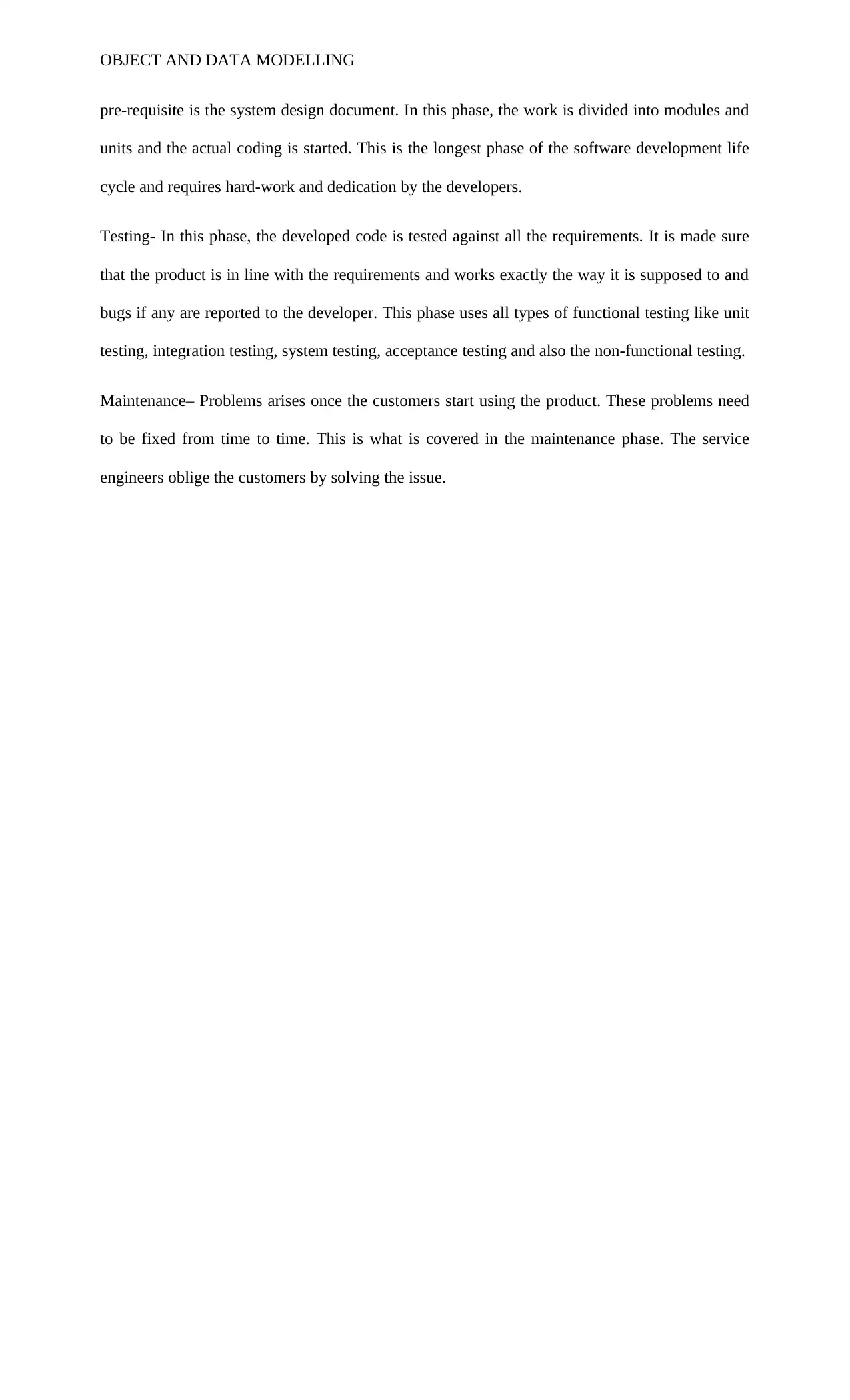
OBJECT AND DATA MODELLING
pre-requisite is the system design document. In this phase, the work is divided into modules and
units and the actual coding is started. This is the longest phase of the software development life
cycle and requires hard-work and dedication by the developers.
Testing- In this phase, the developed code is tested against all the requirements. It is made sure
that the product is in line with the requirements and works exactly the way it is supposed to and
bugs if any are reported to the developer. This phase uses all types of functional testing like unit
testing, integration testing, system testing, acceptance testing and also the non-functional testing.
Maintenance– Problems arises once the customers start using the product. These problems need
to be fixed from time to time. This is what is covered in the maintenance phase. The service
engineers oblige the customers by solving the issue.
pre-requisite is the system design document. In this phase, the work is divided into modules and
units and the actual coding is started. This is the longest phase of the software development life
cycle and requires hard-work and dedication by the developers.
Testing- In this phase, the developed code is tested against all the requirements. It is made sure
that the product is in line with the requirements and works exactly the way it is supposed to and
bugs if any are reported to the developer. This phase uses all types of functional testing like unit
testing, integration testing, system testing, acceptance testing and also the non-functional testing.
Maintenance– Problems arises once the customers start using the product. These problems need
to be fixed from time to time. This is what is covered in the maintenance phase. The service
engineers oblige the customers by solving the issue.
Paraphrase This Document
Need a fresh take? Get an instant paraphrase of this document with our AI Paraphraser
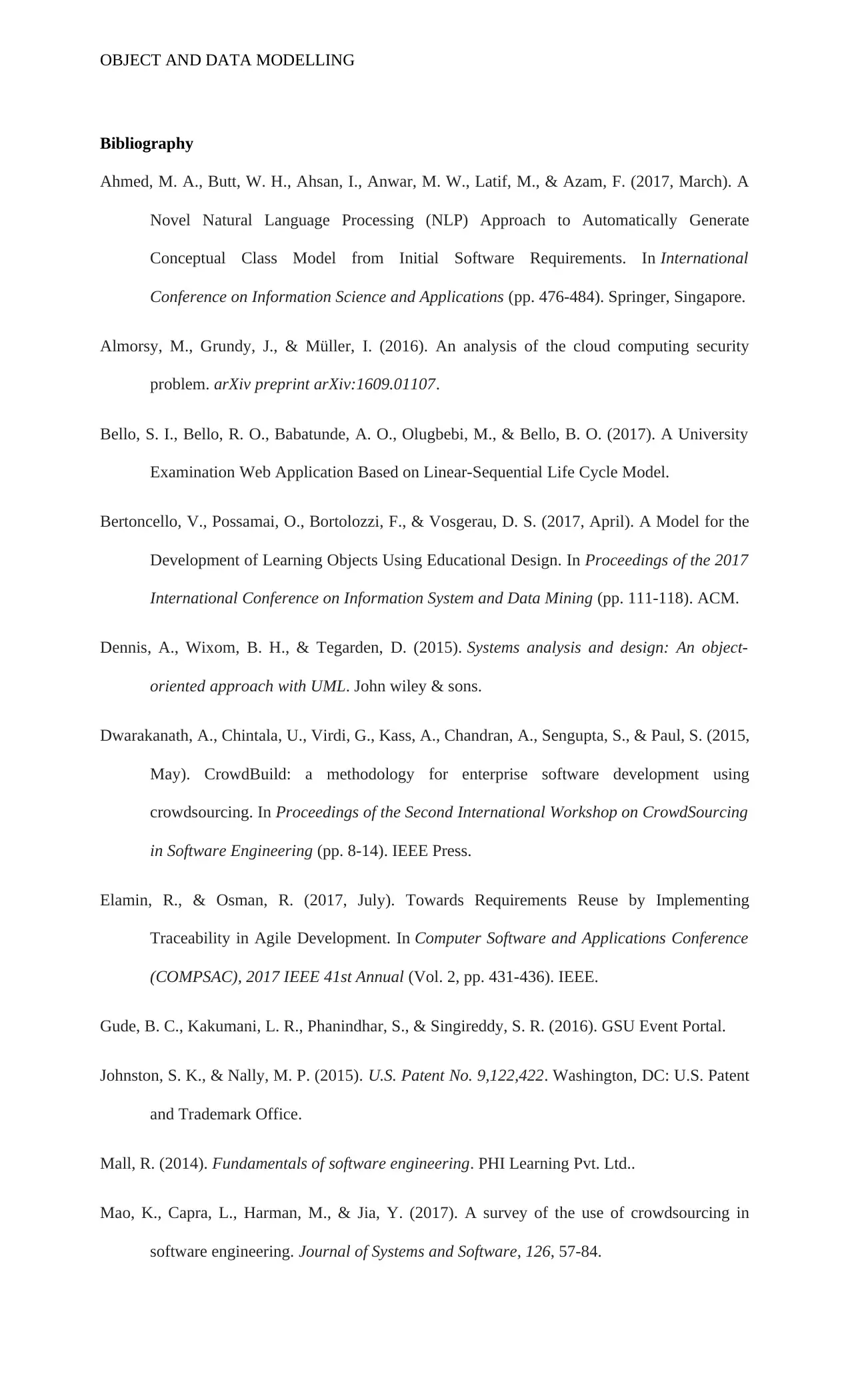
OBJECT AND DATA MODELLING
Bibliography
Ahmed, M. A., Butt, W. H., Ahsan, I., Anwar, M. W., Latif, M., & Azam, F. (2017, March). A
Novel Natural Language Processing (NLP) Approach to Automatically Generate
Conceptual Class Model from Initial Software Requirements. In International
Conference on Information Science and Applications (pp. 476-484). Springer, Singapore.
Almorsy, M., Grundy, J., & Müller, I. (2016). An analysis of the cloud computing security
problem. arXiv preprint arXiv:1609.01107.
Bello, S. I., Bello, R. O., Babatunde, A. O., Olugbebi, M., & Bello, B. O. (2017). A University
Examination Web Application Based on Linear-Sequential Life Cycle Model.
Bertoncello, V., Possamai, O., Bortolozzi, F., & Vosgerau, D. S. (2017, April). A Model for the
Development of Learning Objects Using Educational Design. In Proceedings of the 2017
International Conference on Information System and Data Mining (pp. 111-118). ACM.
Dennis, A., Wixom, B. H., & Tegarden, D. (2015). Systems analysis and design: An object-
oriented approach with UML. John wiley & sons.
Dwarakanath, A., Chintala, U., Virdi, G., Kass, A., Chandran, A., Sengupta, S., & Paul, S. (2015,
May). CrowdBuild: a methodology for enterprise software development using
crowdsourcing. In Proceedings of the Second International Workshop on CrowdSourcing
in Software Engineering (pp. 8-14). IEEE Press.
Elamin, R., & Osman, R. (2017, July). Towards Requirements Reuse by Implementing
Traceability in Agile Development. In Computer Software and Applications Conference
(COMPSAC), 2017 IEEE 41st Annual (Vol. 2, pp. 431-436). IEEE.
Gude, B. C., Kakumani, L. R., Phanindhar, S., & Singireddy, S. R. (2016). GSU Event Portal.
Johnston, S. K., & Nally, M. P. (2015). U.S. Patent No. 9,122,422. Washington, DC: U.S. Patent
and Trademark Office.
Mall, R. (2014). Fundamentals of software engineering. PHI Learning Pvt. Ltd..
Mao, K., Capra, L., Harman, M., & Jia, Y. (2017). A survey of the use of crowdsourcing in
software engineering. Journal of Systems and Software, 126, 57-84.
Bibliography
Ahmed, M. A., Butt, W. H., Ahsan, I., Anwar, M. W., Latif, M., & Azam, F. (2017, March). A
Novel Natural Language Processing (NLP) Approach to Automatically Generate
Conceptual Class Model from Initial Software Requirements. In International
Conference on Information Science and Applications (pp. 476-484). Springer, Singapore.
Almorsy, M., Grundy, J., & Müller, I. (2016). An analysis of the cloud computing security
problem. arXiv preprint arXiv:1609.01107.
Bello, S. I., Bello, R. O., Babatunde, A. O., Olugbebi, M., & Bello, B. O. (2017). A University
Examination Web Application Based on Linear-Sequential Life Cycle Model.
Bertoncello, V., Possamai, O., Bortolozzi, F., & Vosgerau, D. S. (2017, April). A Model for the
Development of Learning Objects Using Educational Design. In Proceedings of the 2017
International Conference on Information System and Data Mining (pp. 111-118). ACM.
Dennis, A., Wixom, B. H., & Tegarden, D. (2015). Systems analysis and design: An object-
oriented approach with UML. John wiley & sons.
Dwarakanath, A., Chintala, U., Virdi, G., Kass, A., Chandran, A., Sengupta, S., & Paul, S. (2015,
May). CrowdBuild: a methodology for enterprise software development using
crowdsourcing. In Proceedings of the Second International Workshop on CrowdSourcing
in Software Engineering (pp. 8-14). IEEE Press.
Elamin, R., & Osman, R. (2017, July). Towards Requirements Reuse by Implementing
Traceability in Agile Development. In Computer Software and Applications Conference
(COMPSAC), 2017 IEEE 41st Annual (Vol. 2, pp. 431-436). IEEE.
Gude, B. C., Kakumani, L. R., Phanindhar, S., & Singireddy, S. R. (2016). GSU Event Portal.
Johnston, S. K., & Nally, M. P. (2015). U.S. Patent No. 9,122,422. Washington, DC: U.S. Patent
and Trademark Office.
Mall, R. (2014). Fundamentals of software engineering. PHI Learning Pvt. Ltd..
Mao, K., Capra, L., Harman, M., & Jia, Y. (2017). A survey of the use of crowdsourcing in
software engineering. Journal of Systems and Software, 126, 57-84.
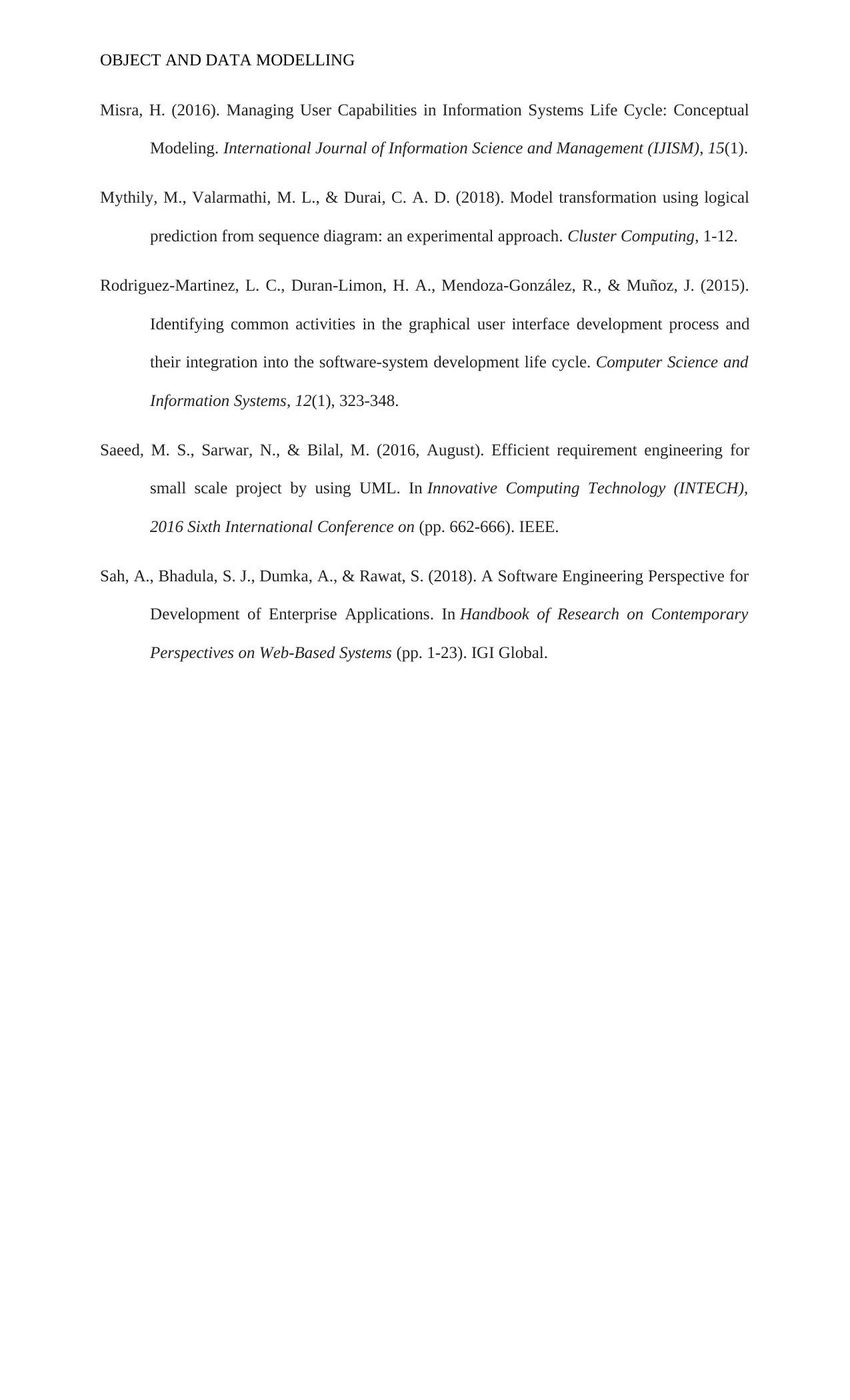
OBJECT AND DATA MODELLING
Misra, H. (2016). Managing User Capabilities in Information Systems Life Cycle: Conceptual
Modeling. International Journal of Information Science and Management (IJISM), 15(1).
Mythily, M., Valarmathi, M. L., & Durai, C. A. D. (2018). Model transformation using logical
prediction from sequence diagram: an experimental approach. Cluster Computing, 1-12.
Rodriguez-Martinez, L. C., Duran-Limon, H. A., Mendoza-González, R., & Muñoz, J. (2015).
Identifying common activities in the graphical user interface development process and
their integration into the software-system development life cycle. Computer Science and
Information Systems, 12(1), 323-348.
Saeed, M. S., Sarwar, N., & Bilal, M. (2016, August). Efficient requirement engineering for
small scale project by using UML. In Innovative Computing Technology (INTECH),
2016 Sixth International Conference on (pp. 662-666). IEEE.
Sah, A., Bhadula, S. J., Dumka, A., & Rawat, S. (2018). A Software Engineering Perspective for
Development of Enterprise Applications. In Handbook of Research on Contemporary
Perspectives on Web-Based Systems (pp. 1-23). IGI Global.
Misra, H. (2016). Managing User Capabilities in Information Systems Life Cycle: Conceptual
Modeling. International Journal of Information Science and Management (IJISM), 15(1).
Mythily, M., Valarmathi, M. L., & Durai, C. A. D. (2018). Model transformation using logical
prediction from sequence diagram: an experimental approach. Cluster Computing, 1-12.
Rodriguez-Martinez, L. C., Duran-Limon, H. A., Mendoza-González, R., & Muñoz, J. (2015).
Identifying common activities in the graphical user interface development process and
their integration into the software-system development life cycle. Computer Science and
Information Systems, 12(1), 323-348.
Saeed, M. S., Sarwar, N., & Bilal, M. (2016, August). Efficient requirement engineering for
small scale project by using UML. In Innovative Computing Technology (INTECH),
2016 Sixth International Conference on (pp. 662-666). IEEE.
Sah, A., Bhadula, S. J., Dumka, A., & Rawat, S. (2018). A Software Engineering Perspective for
Development of Enterprise Applications. In Handbook of Research on Contemporary
Perspectives on Web-Based Systems (pp. 1-23). IGI Global.
⊘ This is a preview!⊘
Do you want full access?
Subscribe today to unlock all pages.

Trusted by 1+ million students worldwide
1 out of 12
Related Documents
Your All-in-One AI-Powered Toolkit for Academic Success.
+13062052269
info@desklib.com
Available 24*7 on WhatsApp / Email
![[object Object]](/_next/static/media/star-bottom.7253800d.svg)
Unlock your academic potential
Copyright © 2020–2025 A2Z Services. All Rights Reserved. Developed and managed by ZUCOL.





